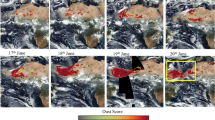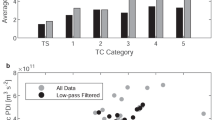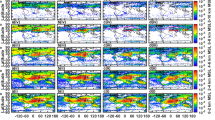Abstract
Mineral dust is usually transported long distances in the lower troposphere. There are examples of Asian dust being transported across the Pacific Ocean1,2,3,4,5,6,7, and traces of Asian dust have also been found in ice and snow cores in Greenland8 and the French Alps9. Here, we use measurements from the Cloud–Aerosol Lidar with Orthogonal Polarization10, an air parcel trajectory model and a three-dimensional aerosol transport model to map the transport of dust clouds generated during a storm in China’s Taklimakan Desert during May 2007. We show that the dust-veiled clouds were lofted to the upper troposphere around 8–10 km above the Earth’s surface and transported more than one full circuit around the globe in about 13 days. When the dust reached the northwestern Pacific Ocean for the second time, the subsidence of a large-scale high-pressure system caused it to descend into the lower troposphere; some of the dust was then deposited over the ocean. Our analysis also indicates that the dust particles may have acted as ice nuclei in these high-altitude clouds, leading to the formation of cirrus clouds. We suggest that Asian dust can influence the global radiation budget by stimulating cirrus cloud formation and marine ecosystems by supplying nutrients to the open ocean.
This is a preview of subscription content, access via your institution
Access options
Subscribe to this journal
Receive 12 print issues and online access
$259.00 per year
only $21.58 per issue
Buy this article
- Purchase on Springer Link
- Instant access to full article PDF
Prices may be subject to local taxes which are calculated during checkout


Similar content being viewed by others
References
Uno, I. et al. Trans-Pacific yellow sand transport observed in April 1998: A numerical simulation. J. Geophys. Res. 106, 18331–18344 (2001).
Takemura, T., Uno, I., Nakajima, T., Higurashi, A. & Sano, I. Modeling study of long-range transport of Asian dust and anthropogenic aerosols from East Asia. Geophys. Res. Lett. 29, 2158 (2002).
Jaffe, D. et al. Transport of Asian air pollution to North America. Geophys. Res. Lett. 26, 711–714 (1999).
McKendry, I. G. et al. Trans-Pacific dust events observed at Whistler, British Columbia during INTEX-B. Atmos. Chem. Phys. 8, 6297–6307 (2008).
Tanaka, T. et al. Possible transcontinental dust transport from North Africa and the Middle East to East Asia. Atmos. Environ. 39, 3901–3909 (2005).
Betzer, P. R. et al. Long-range transport of giant mineral aerosol particles. Nature 336, 568–571 (1988).
McKendry, I. G. et al. A case of trans-Pacific transport of Saharan Dust to Western North America. J. Geophys. Res. 112, D01103 (2007).
Bory, A. J.-M., Biscaye, P. E. & Grousset, F. E. Two distinct seasonal Asian source regions for mineral dust deposited in Greenland (NorthGRIP). Geophys. Res. Lett. 30, 1167 (2003).
Grousset, F. E., Ginoux, P., Bory, A. & Biscaye, P. E. Case study of a Chinese dust plume reaching the French Alps. Geophys. Res. Lett. 30, 1277 (2003).
Winker, D. M., Hunt, W. H. & McGill, M. J. Initial performance assessment of CALIOP. Geophys. Res. Lett. 34, L19803 (2007).
Shimizu, A. et al. Continuous observations of Asian dust and other aerosols by polarization lidars in China and Japan during ACE-Asia. J. Geophys. Res. 109, D19S17 (2004).
Liu, Z. et al. CALIPSO lidar observations of the optical properties of Saharan dust: A case study of long-range transport. J. Geophys. Res. 113, D07207 (2008).
Uno, I. et al. 3D structure of Asian dust transport revealed by CALIPSO lidar and a 4DVAR dust model. Geophys. Res. Lett. 35, L06803 (2008).
Eguchi, K. et al. Trans-Pacific dust transport: Integrated analysis of NASA/CALIPSO and a global aerosol transport model. Atmos. Chem. Phys. 9, 3137–3145 (2009).
Aoki, I., Kurosaki, Y., Osada, R., Sato, T. & Kimura, F. Dust storms generated by mesoscale cold fronts in the Tarim Basin, Northwest China. Geophys. Res. Lett. 32, L06807 (2005).
Draxler, R. R. & Hess, G. D. An overview of the HYSPLIT 4 modelling system for trajectories, dispersion, and deposition. Aust. Meteorol. Mag. 47, 295–308 (1998).
Takemura, T. et al. Global three-dimensional simulation of aerosol optical thickness distribution of various origins. J. Geophys. Res. 105, 17853–17873 (2000).
Sugimoto, N. et al. 23rd International Laser Radar Conference, July 2006 Nara, Japan 851–854 23ILRC, ISBN 4- 9902916-0-3 (2006).
Wong, C. S., Whitney, F. A., Matear, R. J. & Iseki, K. Enhancement of new production in the northeast subarctic Pacific Ocean during negative North Pacific index events. Limnol. Oceanogr. 43, 1418–1426 (1998).
Isono, K., Komabayashi, M. & Ono, A. The nature and the origin of ice nuclei in the atmosphere. J. Meteorol. Soc. Jpn. 37, 211–233 (1959).
Sassen, K. Indirect climate forcing over the western US from Asian dust storms. Geophys. Res. Lett. 29, 1465 (2002).
Sakai, T., Nagai, T., Nakazato, M. & Matsumura, T. Raman lidar measurement of water vapor and ice clouds associated with Asian dust layer over Tsukuba, Japan. Geophys. Res. Lett. 31, L06128 (2004).
Sokolik, I. N. & Toon, O. B. Direct radiative forcing by anthropogenic airborne mineral aerosols. Nature 381, 681–683 (1996).
Tegen, I., Lacis, A. A. & Fung, I. The influence on climate forcing on mineral aerosols from disturbed soils. Nature 380, 419–422 (1996).
Hara, Y., Uno, I. & Wang, Z. Long-term variation of Asian dust and related climate factor. Atmos. Environ. 40, 6730–6740 (2006).
Sun, J., Zhang, M. & Liu, T. Spatial and temporal characteristics of dust storms in China and its surrounding regions, 1960–1999: Relations to source area and climate. J. Geophys. Res. 106, 10325–10333 (2001).
Zhu, C., Wang, B. & Qian, W. Why do dust storms decrease in northern China concurrently with the recent global warming. Geophys. Res. Lett. 35, L18702 (2008).
Hartmann, D. L. et al. The effect of cloud type on Earth’s energy balance: Global analysis. J. Clim. 5, 1281–1304 (1992).
Liu, D., Wang, Z., Liu, Z., Winker, D. & Trepte, C. A height resolved global view of dust aerosols from the first year CALIPSO lidar measurements. J. Geophys. Res. 113, D16214 (2008).
Fernald, F. G. Analysis of atmospheric LIDAR observations: Some comments. Appl. Opt. 23, 652–653 (1984).
Acknowledgements
This work was partly supported by the Grant-in-Aid for Scientific Research in Priority Areas ‘Western Pacific Air–Sea Interaction Study (W-PASS)’ under the Grant No. 18067005 from the Ministry of Education, Culture, Sports, Science and Technology (MEXT), Japan and by the Global Environment Research Fund, Ministry of Environment, Japan (C-061). The authors gratefully thank M. Mikami for his continuous encouragement during the work of this paper, and C. Hostetler for his valuable comments on the original manuscript and English proofreading. The CALIPSO data were obtained from the NASA Langley Research Center Atmospheric Sciences Data Center.
Author information
Authors and Affiliations
Contributions
I.U., K.E. and K.Y. designed the entire study and coordinated all of the analyses. T.T. developed the SPRINTARS model and applied it in the global dust transport analysis. A.S., Y.H. and N.S. carried out the ground-based lidar measurement and analysis. Z.L. supported the CALIPSO data analysis. Z.W. examined the Chinese dust event data. M.U. interpreted the deposition analysis. I.U. and Z.L. wrote the manuscript with valuable inputs from all authors and M.U. led the finalization of the manuscript.
Corresponding author
Supplementary information
Supplementary Fig. S1
Supplementary Information (PDF 3174 kb)
Rights and permissions
About this article
Cite this article
Uno, I., Eguchi, K., Yumimoto, K. et al. Asian dust transported one full circuit around the globe. Nature Geosci 2, 557–560 (2009). https://doi.org/10.1038/ngeo583
Received:
Accepted:
Published:
Issue Date:
DOI: https://doi.org/10.1038/ngeo583
This article is cited by
-
Atmospheric deposition and river runoff stimulate the utilization of dissolved organic phosphorus in coastal seas
Nature Communications (2024)
-
Historical footprints and future projections of global dust burden from bias-corrected CMIP6 models
npj Climate and Atmospheric Science (2024)
-
Millennial-scale variability of Greenland dust provenance during the last glacial maximum as determined by single particle analysis
Scientific Reports (2024)
-
Pollen and grain size characteristics recorded from evaporite in the Kumishi Basin in arid Central Asia: implications for climate and environmental change since the late glacial
Carbonates and Evaporites (2024)
-
A 1000-year hydroclimate record from the Asian summer monsoon-Westerlies transition zone in the northeastern Qinghai-Tibetan Plateau
Climatic Change (2023)



